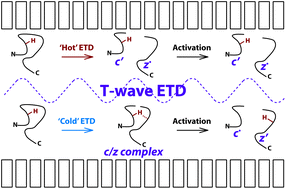Our official English website, www.x-mol.net, welcomes your
feedback! (Note: you will need to create a separate account there.)
A broader view on ion heating in traveling-wave devices using fragmentation of CsI clusters and extent of H˙ migration as molecular thermometers
Analyst ( IF 3.6 ) Pub Date : 2017-08-09 00:00:00 , DOI: 10.1039/c7an00161d Frederik Lermyte 1, 2, 3, 4, 5 , Frank Sobott 1, 2, 3, 4, 5
Analyst ( IF 3.6 ) Pub Date : 2017-08-09 00:00:00 , DOI: 10.1039/c7an00161d Frederik Lermyte 1, 2, 3, 4, 5 , Frank Sobott 1, 2, 3, 4, 5
Affiliation

|
Electron transfer dissociation (ETD) is becoming increasingly important in mass spectrometry-based analysis of peptides and proteins. Supplemental collisional activation of undissociated electron transfer products can significantly increase fragmentation yield and sequence coverage, but hydrogen rearrangements – specifically, transfer of a hydrogen radical from a c to a z fragment – lead to distorted isotope distributions and increased potential for signal overlap. Concomitant collisional activation during the ion/ion reaction significantly reduces these rearrangements, but, in ion traps, also leads to lower reaction rates and reduced overlap of anion and cation clouds. In traveling-wave ion mobility devices, it has been reported – although not under ETD conditions – that significant ion activation can occur depending on the T-wave height and velocity. Here, we investigate this phenomenon in more detail using a commercial instrument (Waters Synapt G2) and report that a similar effect can be induced within the traveling-wave Trap cell where the ETD reaction occurs, using fairly typical T-wave settings. This ion ‘heating’ is demonstrated by analyzing the observed isotope distributions (sensitive to the aforementioned hydrogen rearrangements) of ETD fragments of ubiquitin and substance P. A more detailed investigation of ion activation using cesium iodide clusters (without ETD reagent anions present) shows that the observed behavior is consistent with the known dynamics of ions within traveling-wave devices. The insights gained in this work are potentially relevant both for ‘native ETD’ studies (in which tuning needs to be optimized to avoid unintentional ion activation) as well as the design of future T-wave ETD devices (where this ‘heating’ effect might be exploited to promote fragment release).
中文翻译:

使用CsI团簇的碎裂和H˙迁移程度作为分子温度计的行波设备中离子加热的更广阔视野
在基于质谱的肽和蛋白质分析中,电子转移解离(ETD)变得越来越重要。未离解的电子转移产物的补充碰撞活化可以显着提高片段化产率和序列覆盖率,但会发生氢重排,特别是氢自由基从c转移到z碎片–导致同位素分布失真和信号重叠的可能性增加。离子/离子反应过程中伴随的碰撞活化显着降低了这些重排,但在离子阱中,也导致了较低的反应速率并减少了阴离子和阳离子云的重叠。据报道,尽管不是在ETD条件下,在行波离子迁移率设备中,取决于T波的高度和速度,可能会发生明显的离子活化。在这里,我们使用商用仪器(Waters Synapt G2)更详细地研究这种现象,并报告说,使用相当典型的T波设置,可以在发生ETD反应的行波陷阱单元内诱发类似的效果。通过分析观察到的遍在蛋白和物质P的ETD片段的同位素分布(对上述氢重排敏感)可以证明这种离子“加热”。使用碘化铯簇(不存在ETD试剂阴离子)对离子活化的更详细研究表明:观察到的行为与行波设备中已知的离子动力学一致。在这项工作中获得的见解可能与“本机ETD”研究(需要优化调整以避免意外的离子活化)以及未来T波ETD设备的设计(在这种情况下,“加热”效果可能被利用来促进片段的释放)。使用碘化铯簇(不存在ETD试剂阴离子)对离子活化的更详细研究表明,观察到的行为与行波装置中离子的已知动力学一致。在这项工作中获得的见解可能与“本机ETD”研究(需要优化调整以避免意外的离子活化)以及未来T波ETD设备的设计(在这种情况下,“加热”效应可能会产生影响)相关。被利用来促进片段的释放)。使用碘化铯簇(不存在ETD试剂阴离子)对离子活化的更详细研究表明,观察到的行为与行波装置中离子的已知动力学一致。在这项工作中获得的见解可能与“本机ETD”研究(需要优化调整以避免意外的离子活化)以及未来T波ETD设备的设计(在这种情况下,“加热”效应可能会产生影响)相关。被利用来促进片段的释放)。
更新日期:2017-09-08
中文翻译:

使用CsI团簇的碎裂和H˙迁移程度作为分子温度计的行波设备中离子加热的更广阔视野
在基于质谱的肽和蛋白质分析中,电子转移解离(ETD)变得越来越重要。未离解的电子转移产物的补充碰撞活化可以显着提高片段化产率和序列覆盖率,但会发生氢重排,特别是氢自由基从c转移到z碎片–导致同位素分布失真和信号重叠的可能性增加。离子/离子反应过程中伴随的碰撞活化显着降低了这些重排,但在离子阱中,也导致了较低的反应速率并减少了阴离子和阳离子云的重叠。据报道,尽管不是在ETD条件下,在行波离子迁移率设备中,取决于T波的高度和速度,可能会发生明显的离子活化。在这里,我们使用商用仪器(Waters Synapt G2)更详细地研究这种现象,并报告说,使用相当典型的T波设置,可以在发生ETD反应的行波陷阱单元内诱发类似的效果。通过分析观察到的遍在蛋白和物质P的ETD片段的同位素分布(对上述氢重排敏感)可以证明这种离子“加热”。使用碘化铯簇(不存在ETD试剂阴离子)对离子活化的更详细研究表明:观察到的行为与行波设备中已知的离子动力学一致。在这项工作中获得的见解可能与“本机ETD”研究(需要优化调整以避免意外的离子活化)以及未来T波ETD设备的设计(在这种情况下,“加热”效果可能被利用来促进片段的释放)。使用碘化铯簇(不存在ETD试剂阴离子)对离子活化的更详细研究表明,观察到的行为与行波装置中离子的已知动力学一致。在这项工作中获得的见解可能与“本机ETD”研究(需要优化调整以避免意外的离子活化)以及未来T波ETD设备的设计(在这种情况下,“加热”效应可能会产生影响)相关。被利用来促进片段的释放)。使用碘化铯簇(不存在ETD试剂阴离子)对离子活化的更详细研究表明,观察到的行为与行波装置中离子的已知动力学一致。在这项工作中获得的见解可能与“本机ETD”研究(需要优化调整以避免意外的离子活化)以及未来T波ETD设备的设计(在这种情况下,“加热”效应可能会产生影响)相关。被利用来促进片段的释放)。











































 京公网安备 11010802027423号
京公网安备 11010802027423号